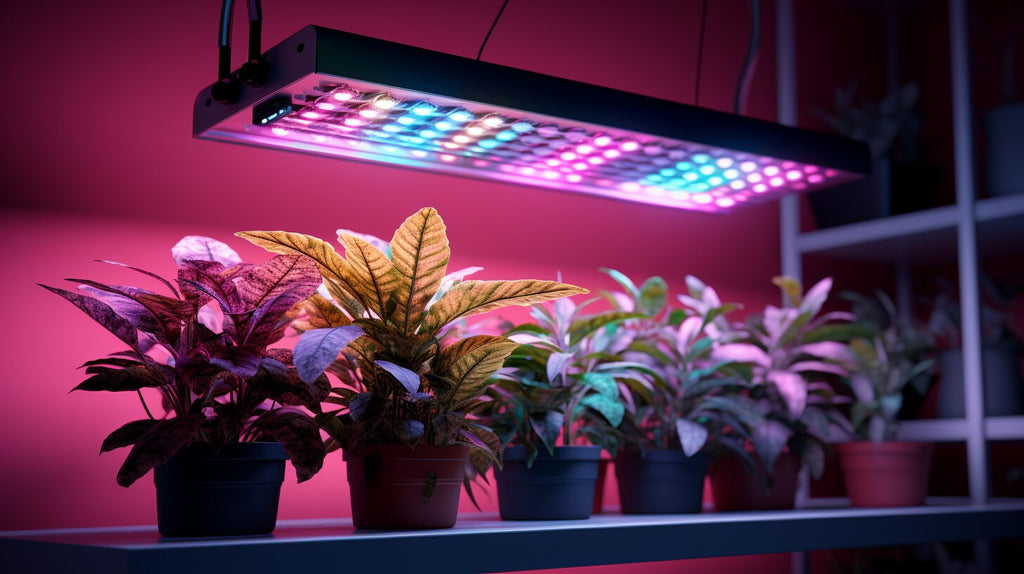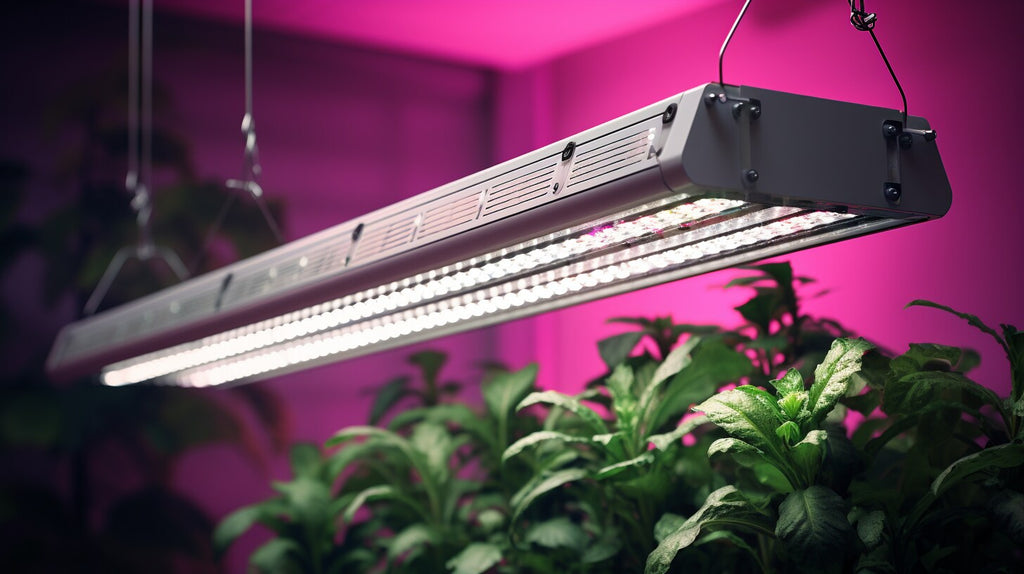Types of LED Grow Lights
Understanding the types of LED grow lights is inevitable when you want to give your plants all the light they deserve.
These lights, modeled after the sun, cater to the photosynthetic needs of plants, creating a blooming indoor oasis. From full-spectrum to adjustable spectrum lights, LED grow lights come in various types, each offering unique benefits.
Tailoring your choice of light to the specific needs of your plants is crucial for their growth and vitality. As we delve into this guide, we will illuminate the paths of indoor gardening and help you make informed decisions. Let's brighten up your plant's day with the right LED Grow light!
Importance of LED Grow Lights

LED grow lights are key for indoor gardening success. They give plants the light they need to grow well. Unlike the sun, these lights won't make your room too hot. They also use less electricity, saving you money on bills.
Plants love LED grow lights because they can mimic sunlight. This helps plants create food through photosynthesis even when there is no real sun around. With LEDs, gardeners can control how much light their plants get.
This makes sure every plant gets just what it needs to be strong and healthy.
Popular brands of LED grow lights our shop has to offer:
- Spider Farmer Grow Lights
- Mars Hydro Grow Lights
- AC Infinity Grow Lights
- Philips LED Grow Lights
- Kind LED Grow Lights
Different Types of LED Grow Lights
In the world of indoor plant cultivation, LED grow lights have revolutionized how we provide our green friends with the essential lumens they crave. Let's dive into the spectrum of options available, from innovative full-spectrum designs to targeted color combinations, each tailored to optimize plant growth at various stages.
Full Spectrum LED Grow Lights

Full spectrum LED grow lights are like giving your plants a bit of the sun inside. They shine in all colors that plants need to grow strong and healthy. These lights have both blue and red rays, which help leaves grow big and flowers bloom bright.
Many indoor gardeners love these lights because they can support a plant from seedling to fruit without changing bulbs. This makes full-spectrum LED grow lights perfect for all stages of plant life.
And since they use less power, they save money on electricity bills too!
Read More: Best LED Grow Lights
White LED Grow Lights

White LED grow lights shine bright for indoor gardens and hydroponic setups. They come in warm white or cool white options, giving you choices for your plants. Warm white LEDs are like cozy sunlight that can help with the flowering stage.
Cool whites mimic daylight and can keep plants short and bushy. These lights look great in your home too! They blend right in because they give off light that looks just natural.
Plants need blue and red light to really do well, but white LEDs can also have some blue in them. You can find adjustable spectrum LED grow lights if you want more control over how your plants grow.
With the right amount of blue from these lights, you could get even healthier plants! Plus, they fit into different lamps and fixtures, so it's easy to match them with your room's look while helping your green friends thrive.
Red and Blue LED Grow Lights

Red and blue LED grow lights are like a power duo for plants. They hit just the right notes to help with photosynthesis, which is how plants convert light into energy. The blue LEDs get leaves and stems growing strong and sturdy.
It's perfect when you want your plants to have a good structure in their early days.
Switching over, red LEDs take the stage during flowering and fruiting times. They make sure plants produce plenty of flowers and fruits. But here's the thing: red light alone could make your plants too tall and weak.
That's why mixing in some blue hues is key for that optimal spectrum that gets everything just right—from leafy growth to stem stretch—leading to happy, healthy indoor gardens.
Interestingly, lettuce cultivars grown under various combinations of blue and red LEDs exhibited differences in leaf shape, plant growth, and antioxidant phenolic compounds. ( Link )
Read More: How To Hang Your Grow Lights
Programmable and Remote-Control LED Grow Lights
Moving on from red and blue lights, let's talk about programmable and remote-controlled LED grow lights. These give you the power to shape light just how your plants need it. You can change light colors, intensity, and when the lights turn on or off.
It's like having a smart system for your indoor garden. This way, you can help your plants at every stage – whether they're just sprouting or ready to flower.
With these advanced systems, you don't even need to be in the same room as your plants. You can use a phone or computer to check on things and make changes. Imagine making sure your plants get sunset-like light while sitting on the couch! Plus, these systems are smart enough to follow schedules all by themselves once set up right.
This tech makes growing indoors easier and helps plants thrive just as they would outside under the sun.
Read More: LED Grow Light Safety
Factors to Consider When Choosing LED Grow Lights

Selecting the right LED grow light involves more than just picking the brightest option off the shelf; it's a delicate balance of various elements tailored to your plant's specific needs.
Understanding these factors helps pinpoint the optimal lighting solution that not only accelerates plant growth but also maximizes energy efficiency and minimizes heat issues, ensuring your indoor garden thrives.
Our picks for you:
- Mars Hydro SP 3000 Full Spectrum Grow Light
- Mars Hydro SP 3000 Full Spectrum Grow Light
- Spider Farmer® SF4000 450W LED Grow Light
Light Spectrum Needs
Plants love light, but not all light is the same. They need specific types of light to grow strong and healthy. Think of full-spectrum LED grow lights as a mini sun for your plants.
They give off a mix that includes blue, red, and even green lights. The blue light makes your plants have strong leaves, while the red helps them bloom and bear fruit.
Your plants are like people with different tastes; they thrive under various colors of light at different stages in their life. Early on, more blue might be best, but later, red could be just what they need.
Also, remember how nature works outside—plants get both quality and quantity of light during the day. You should aim to mimic this inside with your LEDs to make sure your greens get what they crave for perfect growth.
Read More: LED Grow Light Accessories
Coverage Area
Choosing the right LED grow light means thinking about how much space you need to cover. The coverage area is all about the size of your indoor garden or hydroponic setup. Some lights are made for small spaces, while others can handle bigger areas where lots of plants live together.
You'll want a light that shines over all your plants evenly so they can grow well.
It's smart to check the light’s details because they tell you how big an area it can cover at different heights. Make sure your light is strong enough to reach tall plants but not too powerful for tiny seedlings.
Imagine a blanket of light that needs to fit just right – not too small and not hanging off the edges. This way, every plant gets its share of sunshine without any waste or missing spots.
Power Consumption and Efficiency

Once you've measured the size of your grow space, it's time to think about how much energy your LED lights will use. LED grow lights shine in this area because they consume less power than other types.
This means you can save on your electricity bill every month. They turn more energy into light and less into heat, which is good for your plants and your pocket.
LEDs are built to last longer, too, so they don't need to be replaced as often as other lights. You won’t just cut down on power usage; you'll also spend less money over time. Keeping an eye on energy efficiency helps keep costs low while still giving strong light to help plants grow big and healthy.
Remember that high light intensity doesn't always mean high power consumption with LEDs—these lights balance both well.
Read More: Setting Up an LED Grow Light System
Heat Output and Cooling Systems
Moving from power matters to controlling heat, LED grow lights stand out for their cooler operation compared to other types of grow lights. They give off less heat, which means you don't need big, costly cooling systems.
This is a win for your plants and your wallet! But even with LEDs, some heat will always be there — managing it is key.
Plants are sensitive to temperature. Too much warmth can stress them out or worse. That's why good LED grow lights have built-in ways to manage heat. They might use a heatsink or a fan to keep things cool.
Some high-tech ones even use water because it's great at soaking up heat without getting too hot itself. Remember, keeping your growing room at the right temperature helps your plants stay happy and healthy while making sure the lights work well for longer!
Price and Longevity
LED grow lights cost more than other types at first. But they last a long time and save money on power. This makes them good for your wallet over many years. They don't break easily either, so you won't need to buy new ones often.
Think of LED lights as a smart buy for your indoor garden or water-grown plants. The price is high at the start, but it pays off as you use less energy and keep them longer. Trust that this choice will help both your plants and your savings grow strong!
Benefits of Using LED Grow Lights

LED grow lights save you money on your energy bill. They use less power than other types of lights, which means they are gentle on your wallet over time. These lights also keep things cooler compared to others, reducing the need for fans or air conditioning.
This can mean even more savings and a happier environment for your plants.
Plants love the high-quality light from LEDs, too. It helps them grow strong and healthy indoors where the sun doesn't shine. LED lights are built to last a long time without burning out quickly.
This means you won't have to replace them as often as other bulbs, giving you one less thing to worry about while keeping your indoor garden green and flourishing.
Read More: Benefits of LED Grow Lights
Personal Experience
My plants are thriving, and it's all thanks to the switch to LED grow lights. These lights don't get too hot, which means I don't have to worry much about overheating my indoor garden.
The energy they save is a big plus as well—I've noticed a drop in my electricity bills since making the change.
I've experimented with several lighting setups over time, but LEDs stand out for their efficiency. Their long life saves me money because I'm not always buying new bulbs. Each plant gets just the right light from my full-spectrum LEDs, showing me this technology really supports better plant growth compared to other options I've tried in the past.
Conclusion
From my own garden to yours, the world of LED grow lights opens up endless possibilities. No matter your plant's needs, there's a light out there that fits just right. Remember, look for what suits your space and saves energy, too.
Happy plants mean a happy gardener – and these LEDs are here to make that happen! Keep growing and glowing with the best light for your green friends.
FAQs
What are the main types of LED grow lights?
There are full-spectrum LEDs, broad-spectrum ones, and targeted spectrum lights that match your plants' needs.
Can LED grow lights really help my indoor plants grow?
Yes, using LED grow lights can boost your indoor plants' growth by providing them with similar light to what they'd get from the sun.
Will an LED grow light use up a lot of electricity?
Nope—LED grow lights are energy efficient and won't hike up your electric bill the way older types of grow lights might have done.
How long do LED grow lights last compared to other plant lighting options?
LEDs shine bright for a long time—often outlasting other plant light choices by thousands of hours!
Are there any special features I should look for in an LED grow light system?
Sure thing! Look out for adjustable spectrums, timing settings, and intensity controls to match your garden's unique vibe.








